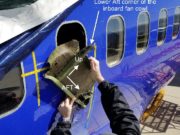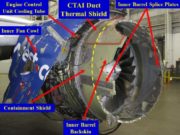A fatigue crack in a fan blade in the engine of a Southwest Airlines Boeing 737-700 was to blame for the chain of events that ended with an uncontained engine failure on Southwest Flight 1380 and the death of a passenger, the U.S. National Transportation Safety Board (NTSB) said today.
In deciding on the probable cause of the accident, the board noted that the fatigue crack in the dovetail of the blade in the airplane’s left engine — one of two CFM International CFM56-7B engines that powered the 737 — resulted in failure of the fan blade. The fan blade failure in turn caused the loss of parts of the engine inlet and fan cowling, the NTSB said. Fragments of the cowling struck the 737’s fuselage and a cabin window, blowing out the window and causing a rapid depressurization. A passenger seated next to the window was killed when she was partially ejected from the airplane in the April 17, 2018, accident, and eight other passengers received minor injuries, the NTSB said.
The flight, which had been bound for Dallas from New York City with 149 passengers and crew, was diverted to Philadelphia International Airport following an emergency descent. The uncontained engine failure left the airplane substantially damaged, the NTSB said.
The NTSB approved not only the final report on the depressurization accident but also seven safety recommendations, including five recommendations to the U.S. Federal Aviation Administration (FAA) that called for a redesign of the fan cowling.
The NTSB said the recommendations “address the need to ensure the structural integrity of the fan cowl on Boeing 737 next-generation airplanes and assess whether other airframe and engine combinations have critical fan blade impact locations, the importance of having flight attendants secured in a jump seat during emergency landings, and guidance for mitigating hazards to passengers affected by an in-flight loss of seating capacity.”
NTSB Chairman Robert Sumwalt added, “It’s not enough to just prevent the failure. We must also actively work and identify ways to minimize the effects if a failure does occur.”

